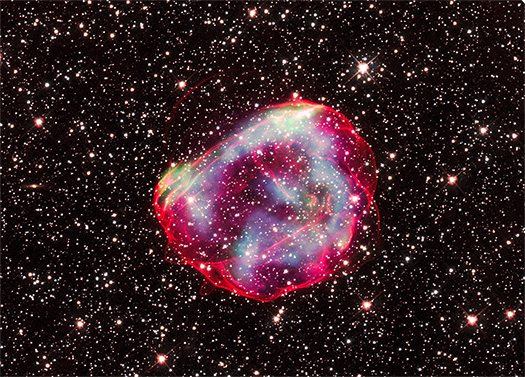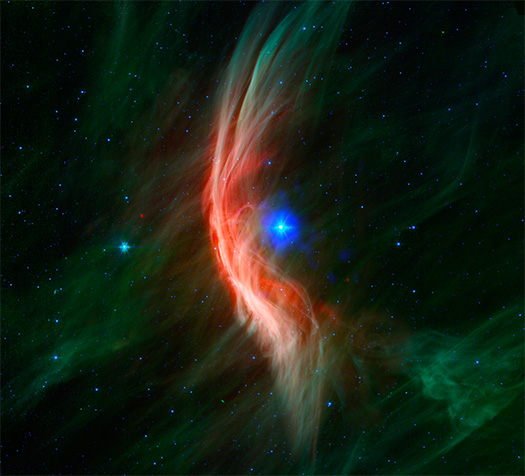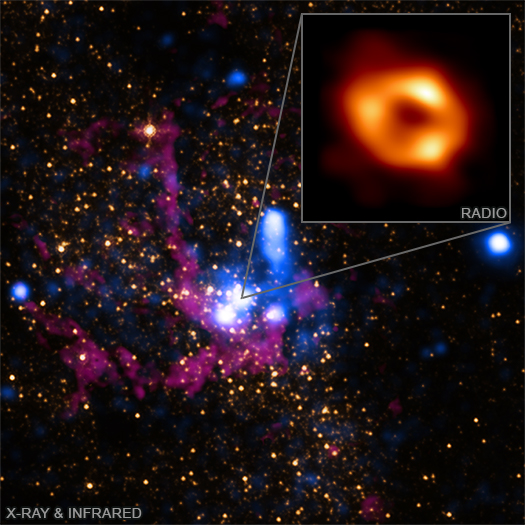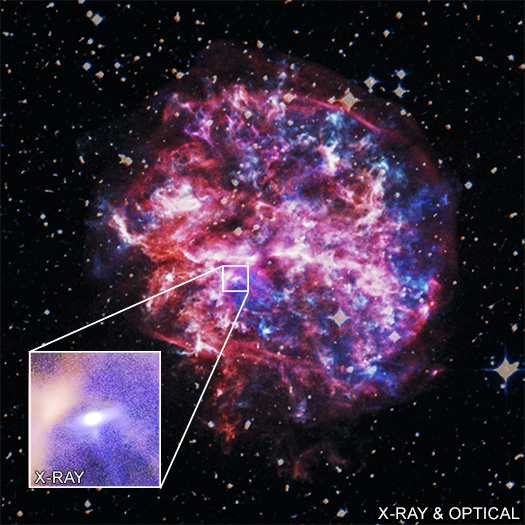New "Realities" of The Cat’s Eye Nebula
There are some objects in space that are so photogenic that their images get circulated far beyond the regular confines of the astronomical community. NASA’s Hubble Space Telescope helped bring attention to the Cat’s Eye when its striking first image was released in 1994. Since then, Hubble has returned to the Cat’s Eye while other telescopes that detect different kinds of light — including NASA’s Chandra X-ray Observatory — have also observed it.
What is the Cat’s Eye? It is officially categorized as a planetary nebula, a misleading label that stuck from its origins in the 19th century. Because these objects look like planets through small telescopes, astronomers named them “planetary nebulas”.
Today, astronomers know these objects have little to do with planets. They are, in fact, a stage toward the end life of stars like our Sun. After the star uses most of its fuel, it puffs off its outer layers while the core shrinks to a stellar nub. Winds and radiation from the star’s core — known as a white dwarf — push and energize the discarded material, sometimes creating spectacular structures. The Cat’s Eye, also known more formally as NGC 6543 and apparently the name of a Stephen King movie from 1985, is a planetary nebula about 3,200 light years from the Earth in the direction of the Draco constellation.
Setting the Clock on a Stellar Explosion

Supernova Remnant 0519-69.0
Credit: X-ray: NASA/CXC/GSFC/B. J. Williams et al.; Optical: NASA/ESA/STScI
While astronomers have seen the debris from scores of exploded stars in the Milky Way and nearby galaxies, it is often difficult to determine the timeline of the star’s demise. By studying the spectacular remains of a supernova in a neighboring galaxy using NASA telescopes, a team of astronomers has found enough clues to help wind back the clock.
The supernova remnant called SNR 0519-69.0 (SNR 0519 for short) is the debris from an explosion of a white dwarf star. After reaching a critical mass, either by pulling matter from a companion star or merging with another white dwarf, the star underwent a thermonuclear explosion and was destroyed. Scientists use this type of supernova, called a Type Ia, for a wide range of scientific studies ranging from studies of thermonuclear explosions to measuring distances to galaxies across billions of light-years.
50 Years Ago, NASA’s Copernicus Set the Bar for Space Astronomy
Your browser does not support the video tag.
With closed-captions (at YouTube)
This vintage segment on Copernicus comes from a 1973 edition of
“The Science Report,” a long-running film series produced by the
U.S. Information Agency. Credit: National Archives (306-SR-138B)
The following blog post is a special feature on the history of astrophysics and space science written by Francis Reddy, a public affairs specialist at NASA’s Goddard Space Flight Center. There is a brief summary of how X-ray astronomy, including the Chandra X-ray Observatory, and practically every other branch of astrophysics benefited from humanity’s success at launching objects into orbit. The original post is available on the NASA portal.
At 6:28 a.m. EDT on Aug. 21, 1972, NASA’s Copernicus satellite, the heaviest and most complex space telescope of its time, lit up the sky as it ascended into orbit from Launch Complex 36B at Cape Canaveral Air Force Station, Florida.
Initially known as Orbiting Astronomical Observatory (OAO) C, it became OAO 3 once in orbit in the fashion of the time. But it was also renamed to honor the upcoming 500th anniversary of the birth of Nicolaus Copernicus (1473 – 1543). The Polish astronomer formulated a model of the solar system with the Sun in the central position instead of Earth, breaking with 1,300 years of tradition and triggering a scientific revolution.
NASA Telescopes Capture Stellar Delivery Service for Black Hole

NGC 4424
Credit: X-ray: NASA/CXC/Swinburne Univ. of Technology/A. Graham et al.; Optical: NASA/ESA/STScI
Astronomers may have witnessed a galaxy’s black hole delivery system in action. A new study using data from NASA’s Chandra X-ray Observatory and Hubble Space Telescope outlines how a large black hole may have been delivered to the spiral galaxy NGC 4424 by another, smaller galaxy.
NGC 4424 is located about 54 million light-years from Earth in the Virgo galaxy cluster. The main panel of this image, which has been previously released, shows a wide-field view of this galaxy in optical light from Hubble. The image is about 45,000 light-years wide. The center of this galaxy is expected to host a large black hole estimated to contain a mass between about 60,000 and 100,000 Suns. There are also likely to be millions of stellar-mass black holes, which contain between about 5 and 30 solar masses, spread throughout the galaxy.
Embracing a Rejected Star

Zeta Ophiuchi
Credit: X-ray: NASA/CXC/Dublin Inst. Advanced Studies/S. Green et al.; Infrared: NASA/JPL/Spitzer
Zeta Ophiuchi is a star with a complicated past, having likely been ejected from its birthplace by a powerful stellar explosion. A new look by NASA's Chandra X-ray Observatory helps tell more of the story of this runaway star.
Located about 440 light-years from Earth, Zeta Ophiuchi is a hot star that is 20 times more massive than the Sun. Previous observations have provided evidence that Zeta Ophiuchi was once in close orbit with another star, before being ejected at about 100,000 miles per hour when this companion was destroyed in a supernova explosion over a million years ago. Previously released infrared data from NASA's now-retired Spitzer Space Telescope, seen in this new composite image, reveals a spectacular shock wave (red and green) that was formed by matter blowing away from the star's surface and slamming into gas in its path. Data from Chandra shows a bubble of X-ray emission (blue) located around the star, produced by gas that has been heated by the effects of the shock wave to tens of millions of degrees.
Chandra Unveils Rotation Speed of One of the Most Massive Black Holes Ever Seen

Julia Sisk-Reynés
Our guest contributor is Julia Sisk-Reynés, the leader of a new black hole study that is the subject of our latest press release. Julia is a second-year PhD student at the Institute of Astronomy at the University of Cambridge, UK, where she is a member of the X-ray group working mainly with Prof. Chris Reynolds and Dr. James Matthews. Her primary focus is on constraining beyond the Standard Model Physics – in particular, axion-like particles (ALPs)- with X-ray observations of cluster-hosted active galaxies. The team have recently set the tightest limits to-date on the coupling of very light ALPs to electromagnetism with Chandra X-ray observations of the cluster-hosted quasar H1821+643. Julia came to Cambridge in 2020, straight after graduating from the University of Manchester with a master’s degree in physics. Amongst others, she did a project on assessing the sensitivity of the DarkSide-20k liquid argon experiment in Gran Sasso, Italy, to direct dark matter detection.
Black holes are one of the most tantalizing objects in the Universe. By 1915, Einstein’s Theory of General Relativity had introduced the notion that the gravity of black holes is so strong that they can distort the space-time around them … to the point where even light close to the black hole cannot escape! More recently, astronomers have gathered evidence that most – if not all – galaxies emitting lots of light at the center (also called active galactic nuclei or AGN) host a very massive black hole at their core. It is known that the properties of AGN and their central black holes are often linked. For example, the heavier the AGN, the heavier its host black hole. Therefore, the formation, growth, and evolution of black holes over time and their connection with the properties of their host galaxies are fascinating topics for astronomers to pursue.
Astronomers classify black holes into three groups, depending on their mass. Firstly, stellar-mass black holes, thought to form from the gravitational collapse of a star, weigh a few to a few tens of times the mass of the Sun. Then, we have a class of black holes of unknown origin which range from hundreds to tens of thousands of Suns, often referred to as “intermediate mass” black holes. A gravitational wave event detected in 2019 by the LIGO and VIRGO collaborations confirmed the existence of a black hole in this second category. Finally, supermassive Black Holes (SMBHs) weigh between millions and billions of Suns. While their origin is still debated, what we do know is that accretion, that is, the feeding of gas onto such black holes, is responsible for the X-ray emission coming from the AGN that surround them.
NASA's Chandra Catches Pulsar in X-ray Speed Trap
The G292.0+1.8 supernova remnant contains a pulsar moving at over a million miles per hour. This image features data from NASA's Chandra X-ray Observatory (red, orange, yellow, and blue), which was used to make this discovery, as discussed in our latest press release. The X-rays were combined with an optical image from the Digitized Sky Survey, a ground-based survey of the entire sky.
Pulsars are rapidly spinning neutron stars that can form when massive stars run out of fuel, collapse and explode. Sometimes these explosions produce a "kick," which is what sent this pulsar racing through the remains of the supernova explosion. An inset shows a close-up look at this pulsar in X-rays from Chandra.
To make this discovery, the researchers compared Chandra images of G292.0+1.8 taken in 2006 and 2016. A pair of supplemental images show the change in position of the pulsar over the 10-year span. The shift in the source's position is small because the pulsar is about 20,000 light-years from Earth, but it traveled about 120 billion miles over this period. The researchers were able to measure this by combining Chandra's high-resolution images with a careful technique of checking the coordinates of the pulsar and other X-ray sources by using precise positions from the Gaia satellite.
Colossal Collisions Linked to Solar System Science
A new study shows a deep connection between some of the largest, most energetic events in the Universe and much smaller, weaker ones powered by our own Sun.
The results come from a long observation with NASA's Chandra X-ray Observatory of Abell 2146, a pair of colliding galaxy clusters located about 2.8 billion light years from Earth. The new study was led by Helen Russell of the University of Nottingham in the United Kingdom.
Galaxy clusters contain hundreds of galaxies and huge amounts of hot gas and dark matter and are among the largest structures in the Universe. Collisions between galaxy clusters release enormous amounts of energy unlike anything witnessed since the big bang and provide scientists with physics laboratories that are unavailable here on Earth.
Looking at the Team Behind the Science

Sagittarius A*: The Black Hole at the Center of the Milky Way Galaxy
Credit: X-ray: NASA/CXC/SAO; IR: NASA/HST/STScI. Inset: Radio (EHT Collaboration)
Many projects in astrophysics involve huge numbers of scientists and other collaborators — often ranging from senior professors to graduate students and undergraduates. A project like the EHT often requires smaller groups within these large collaborations to concentrate on different problems and questions.
The latest result about the Milky Way's central black using many different telescopes in concert with the Event Horizon Telescope (EHT) is an excellent example of such a successful web of groups working together with others in the project to make the sum even greater than its parts.
To learn more about the group behind the "multiwavelength" (MWL) observations that included Chandra and other telescopes, we asked Sera Markoff and Daryl Haggard, two of the coordinators of the EHT's MWL Working Group, a series of questions.
New NASA Black Hole Sonifications with a Remix
Your browser does not support the video tag.
Credit: X-ray: NASA/CXC/Univ. of Cambridge/C. Reynolds et al.; Sonification: NASA/CXC/SAO/K.Arcand, SYSTEM Sounds (M. Russo, A. Santaguida)
Black Hole at the Center of the Perseus Galaxy Cluster (above)
Since 2003, the black hole at the center of the Perseus galaxy cluster has been associated with sound. This is because astronomers discovered that pressure waves sent out by the black hole caused ripples in the cluster's hot gas that could be translated into a note — one that humans cannot hear some 57 octaves below middle C. Now a new sonification brings more notes to this black hole sound machine. This new sonification — that is, the translation of astronomical data into sound — is being released for NASA's Black Hole Week this year.
In some ways, this sonification is unlike any other done before (1, 2, 3, 4) because it revisits the actual sound waves discovered in data from NASA's Chandra X-ray Observatory. The popular misconception that there is no sound in space originates with the fact that most of space is essentially a vacuum, providing no medium for sound waves to propagate through. A galaxy cluster, on the other hand, has copious amounts of gas that envelop the hundreds or even thousands of galaxies within it, providing a medium for the sound waves to travel.



